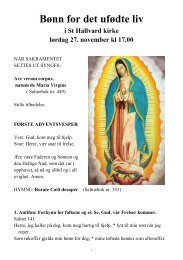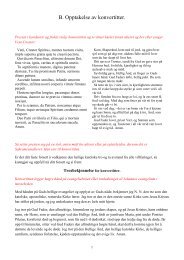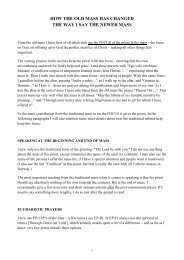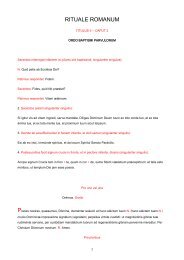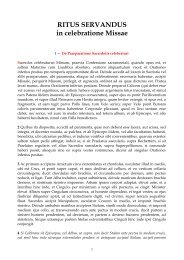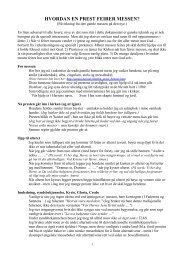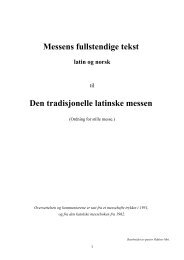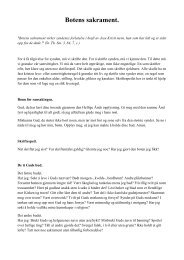oppgaven finner man i sin helhet her
oppgaven finner man i sin helhet her
oppgaven finner man i sin helhet her
Create successful ePaper yourself
Turn your PDF publications into a flip-book with our unique Google optimized e-Paper software.
at musikken danner en slags bakgrunn i liturgien.<br />
Rubrikkene forutsetter <strong>her</strong> at ordinariet og propriene synges til de gregorianske<br />
melodiene i Graduale Ro<strong>man</strong>um (og Liber Usualis) under en missa cantata, som jo er en<br />
høymesse. Dette bekreftes i det siste punktet i rubrikkene, der det forklares hva som er<br />
tillatt å gjøre dersom det er umulig å fremføre sangene slik de står i Liber Usualis:<br />
“X. It is possible that for a good reason some piece assigned to cantors or choir cannot be<br />
sung as noted in the liturgical books; for instance, the <strong>sin</strong>gers are too few, or not<br />
sufficiently skillful, or the chant or the rite is too long. In that case the only alternative<br />
allowed is that the whole piece should be recited recto tono (on one note), or sung to a<br />
Psalm tone; this may be accompanied by the organ.” 62<br />
Det som er obligatorisk i en missa cantata, er at de liturgiske tekstene må synges, og at<br />
alt må synges på latin. Hvis det ikke lar seg gjøre å synge tekstene til melodiene i Liber, går<br />
det an å synge dem til en enklere tonesetting, men det er aldri et alternativ å synge dem på<br />
folkespråket. Det er mulig å synge andre ting i løpet av liturgien, men alltid i tillegg til de<br />
foreskrevne tekstene; det anbefales også å utvide en antifon ved å legge til flere vers etter<br />
behov, før det eventuelt foreslås en latinsk hymne:<br />
” VI. The Offertory is begun by one, two or four cantors, in the same way as the Introit,<br />
and is finished by the full choir.<br />
After the Offertory Antiphon the choir may <strong>sin</strong>g to the ancient Gregorian chants<br />
those Verses which it was once customary to <strong>sin</strong>g at this place.<br />
If the Offertory Antiphon is taken from a Psalm, ot<strong>her</strong> Verses of the same Psalm may be<br />
sung. In that case the Antiphon may be repeated after every Verse or two Verses.<br />
When the Offertory is over, the Psalm ends with Gloria Patri, and the Antiphon is<br />
repeated.<br />
If the Antiphon is not taken from a Psalm, some Psalm suitable to the feast may be<br />
chosen. After the Offertory Antiphon some ot<strong>her</strong> Latin piece may be sung suitable for this<br />
part of the Mass (…).”<br />
“After the Communion, the full choir <strong>sin</strong>gs the Antiphon which is thus named, the<br />
Intonation being sung by one, two or four cantors as in the case of the Introit.<br />
(…) If the Antiphon is taken from a Psalm, ot<strong>her</strong> Verses of the same Psalm may be sung. In<br />
that case the Antiphon may be repeated after every Verse or two Verses; and when the<br />
Communion is ended Gloria Patri followed by the Antiphon is sung.<br />
If the Antiphon is not taken from a Psalm, some Psalm suitable to the feast and to this<br />
part of the Mass may be chosen.<br />
After the Communion Antiphon, especially if the Communion takes a long time, some<br />
ot<strong>her</strong> Latin piece suitable to the occasion may be sung.” 63<br />
62 Liber Usualis, Desclée & Socii, Tournai 1961, Preface to the Vatican Edition of the Ro<strong>man</strong> Chant<br />
(engelsk oversettelse av forordet), s. XV, nr. X<br />
63 Op. cit. s. XV, nr. VI og VIII<br />
42<br />
42



